Mountain Gorilla Orphans Safe after Security Scare in DRC
By Gorilla Doctors Staff on Monday, April 23rd, 2012 in Uncategorized.By Dr. Dawn Zimmerman
At times, we are reminded of the risk that can be involved in caring for mountain gorillas. Perhaps none know this better than our colleagues working in the Democratic Republic of Congo. This was evident just a few weeks ago starting with an email from Linda Nunn, the chair of Gearing up for Gorillas (G4G), a nonprofit organization that provides gear to those that protect and monitor the gorillas. Linda had been staying with us in Musanze, Rwanda, before heading to DRC to deliver some equipment to the staff of Virunga National Park at the Rumangabo park headquarters.
Linda Nunn, chair of Gearing up for Gorillas.The last time Linda was in Rumangabo was in October of 2008, when she was evacuated as Laurent Nkunda’s troops, a political armed militia faction called the National Congress for the Defense of the People (CNDP), advanced and captured Rumangabo from the Congolese army. She described the evacuation as a pretty frightening experience, but said many of the rangers and their families faired far worse, some walking the 45 km back to Goma through the dangerous bush, only to reach a city in chaos with tens of thousands of frightened people displaced from the rural areas.
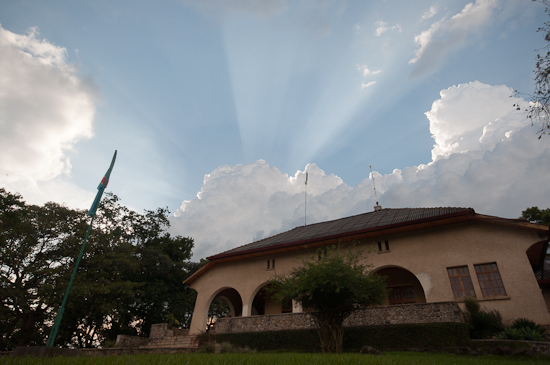 Rumangabo headquarters in Virunga National Park, DRC.This April, Linda returned to Rumangabo and within 14 hours of arriving, she was once again evacuated due to potential military activity. The precautionary evacuation was calm and quiet, but deemed necessary as troops from the remaining CNDP splinter faction, led by warlord Bosco Ntaganda, were gathering north of Rumangabo after rumors of his imminent arrest. Ntaganda is wanted by the International Criminal Court (ICC) for alleged war crimes and crimes against humanity. First indicted in 2006, the ICC has accused Ntaganda of using child soldiers for fighting in northeastern Congo from 2002 to 2003, the end of the Second Congo War that saw some of the worst violence and killed millions. In March, Ntaganda’s co-accused, Thomas Lubanga, was the first person found guilty by the ICC of recruiting child soldiers.
Rumangabo headquarters in Virunga National Park, DRC.This April, Linda returned to Rumangabo and within 14 hours of arriving, she was once again evacuated due to potential military activity. The precautionary evacuation was calm and quiet, but deemed necessary as troops from the remaining CNDP splinter faction, led by warlord Bosco Ntaganda, were gathering north of Rumangabo after rumors of his imminent arrest. Ntaganda is wanted by the International Criminal Court (ICC) for alleged war crimes and crimes against humanity. First indicted in 2006, the ICC has accused Ntaganda of using child soldiers for fighting in northeastern Congo from 2002 to 2003, the end of the Second Congo War that saw some of the worst violence and killed millions. In March, Ntaganda’s co-accused, Thomas Lubanga, was the first person found guilty by the ICC of recruiting child soldiers.
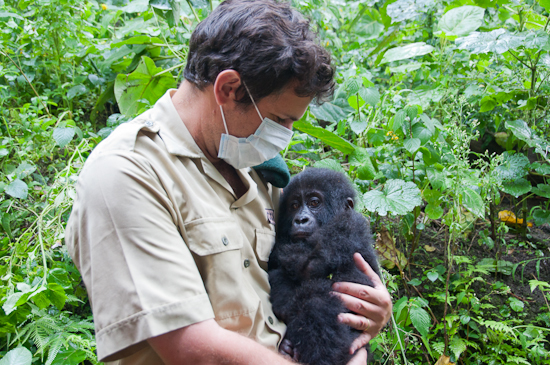 Virunga National Park Chief Park Warden Emmanuel de Merode with the orphan Shamavu.As the troops advanced near Rumangabo, Virunga National Park Chief Park Warden Emmanuel de Merode was concerned for the safety of his staff and wards, including the only captive mountain gorillas in the world housed at Senkwekwe Centre: 5-year-olds Ndeze and Ndakasi (survivors of the 2007 gorilla massacres), 8-year-old Kaboko (the only male), and 10-year-old Maisha. Though these orphans live in a large natural forest enclosure, they rely on their caretakers for their daily needs such as food supplementation and emotional security.
Virunga National Park Chief Park Warden Emmanuel de Merode with the orphan Shamavu.As the troops advanced near Rumangabo, Virunga National Park Chief Park Warden Emmanuel de Merode was concerned for the safety of his staff and wards, including the only captive mountain gorillas in the world housed at Senkwekwe Centre: 5-year-olds Ndeze and Ndakasi (survivors of the 2007 gorilla massacres), 8-year-old Kaboko (the only male), and 10-year-old Maisha. Though these orphans live in a large natural forest enclosure, they rely on their caretakers for their daily needs such as food supplementation and emotional security.
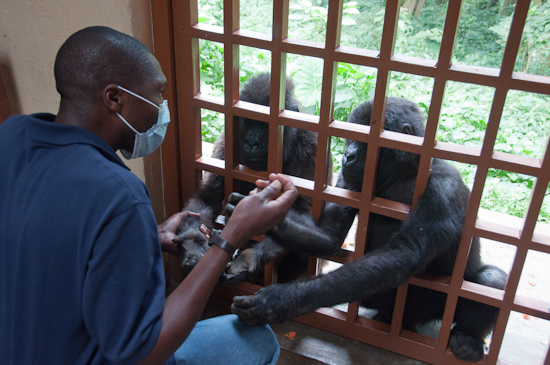 Dr. Eddy with Ndeze and Ndakasi.As the reports came in, it became apparent that the orphans should be evacuated due to security uncertainty. Virunga National Park and Gorilla Doctors’ staff rallied to quickly plan the emergency evacuation before the troops converged north of Rumangabo. Virunga National Park staff started organizing the logistics such as transportation and inspecting the potential holding facility in Goma, while Dr. Eddy and Dr. Noel organized a transfer of crates from Kinigi, Rwanda to Goma, DRC, while I wrote out an anesthetic and transfer protocol.
Dr. Eddy with Ndeze and Ndakasi.As the reports came in, it became apparent that the orphans should be evacuated due to security uncertainty. Virunga National Park and Gorilla Doctors’ staff rallied to quickly plan the emergency evacuation before the troops converged north of Rumangabo. Virunga National Park staff started organizing the logistics such as transportation and inspecting the potential holding facility in Goma, while Dr. Eddy and Dr. Noel organized a transfer of crates from Kinigi, Rwanda to Goma, DRC, while I wrote out an anesthetic and transfer protocol.
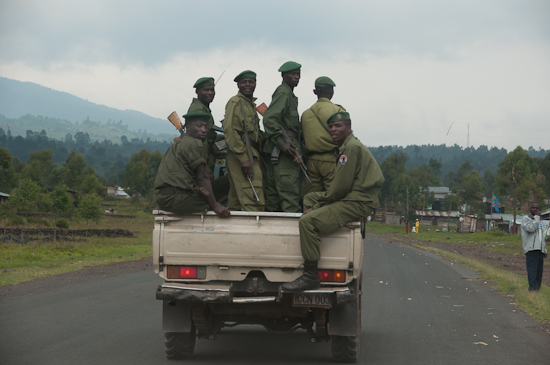 Virunga National Park rangers on the road to Rumangabo.On the drive to Goma, Dr. Noel and I were stopped three times by military to search our vehicle. We later learned that hundreds of soldiers had arrived in Goma that day mainly as a presence to restore calm. It was actually quite calming that the Congolese army was so quick to respond, and that the border patrol was so understanding of our situation and allowed a quick transfer of the crates and emergency veterinary supplies across the border. Unfortunately, it was too dangerous for us to travel the road to Rumangabo, and it was uncertain whether we could get the gorillas out in time before fighting broke out around the region. We anxiously awaited reports from Virunga National Park staff on whether Rumangabo had remained secure. Luckily, within 2 days, tensions calmed and the troops retreated to Masisi, a region west of Rumangabo. The gorilla evacuation was called off.
Virunga National Park rangers on the road to Rumangabo.On the drive to Goma, Dr. Noel and I were stopped three times by military to search our vehicle. We later learned that hundreds of soldiers had arrived in Goma that day mainly as a presence to restore calm. It was actually quite calming that the Congolese army was so quick to respond, and that the border patrol was so understanding of our situation and allowed a quick transfer of the crates and emergency veterinary supplies across the border. Unfortunately, it was too dangerous for us to travel the road to Rumangabo, and it was uncertain whether we could get the gorillas out in time before fighting broke out around the region. We anxiously awaited reports from Virunga National Park staff on whether Rumangabo had remained secure. Luckily, within 2 days, tensions calmed and the troops retreated to Masisi, a region west of Rumangabo. The gorilla evacuation was called off.
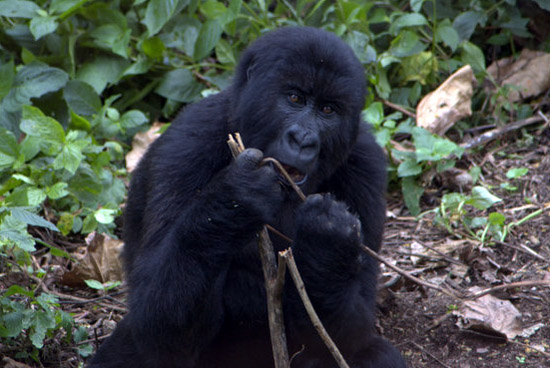 Ndakasi safe at the Senkwekwe Center after the troops left the area.We are happy to have the orphans and their caretakers safe, and are only better prepared for any future security concerns involving Rumangabo. An evacuation is difficult physically, mentally, and logistically with each situation being different; therefore, preparation and organization are paramount. For now, the gorilla crates will stay at Senkwekwe Centre and the emergency evacuation protocol has been refined to include priorities under time limitations, such as the training of ICCN staff and caretakers in options of evacuation under extreme emergency situations. We are glad to have such dedicated partners committed to the safety of these four very important gorillas, in hopes that they will grow up strong and healthy and one day be returned as a family group to the forest.
Ndakasi safe at the Senkwekwe Center after the troops left the area.We are happy to have the orphans and their caretakers safe, and are only better prepared for any future security concerns involving Rumangabo. An evacuation is difficult physically, mentally, and logistically with each situation being different; therefore, preparation and organization are paramount. For now, the gorilla crates will stay at Senkwekwe Centre and the emergency evacuation protocol has been refined to include priorities under time limitations, such as the training of ICCN staff and caretakers in options of evacuation under extreme emergency situations. We are glad to have such dedicated partners committed to the safety of these four very important gorillas, in hopes that they will grow up strong and healthy and one day be returned as a family group to the forest.
You can follow the Gorilla Doctors health monitoring efforts on our Facebook page, where we post photos and notes from our monthly visits.
Please consider supporting MGVP by making a secure online donation. Every dollar you give goes to directly supporting our gorilla health programs and One Health initiative. Thank you for your generosity.


 Donate
Donate